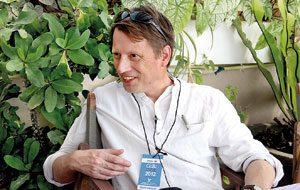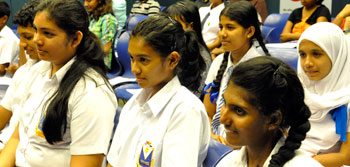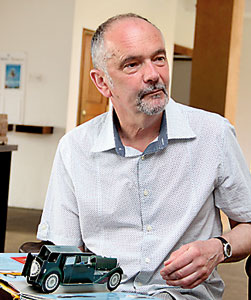Before there was Pottermania and Beatlemania, there was Dickensmania. In his lifetime, Charles Dickens was a phenomenon and now, 200 hundred years after he was born, Dickens remains one of the world’s most beloved novelists. This February marks the author’s bicentenary and it is fuelling a surge of interest in all things Dickensian. At the heart of it all is the man himself. The release of at least three biographies will coincide with the bicentenary and each reveals a life as dramatic and complex as any of his novels and features a maddening protagonist that we are uncertain whether to love or loathe. You’ll have to forgive D.J. Taylor for veering just a tiny bit toward the latter emotion.
 |
| D.J. Taylor in Galle. Pic by Indika Handuwala |
He’s a Thackeray man and the author of a 1999 autobiography of Dickens’ literary rival and contemporary. The British author is fascinated by his Victorian predecessors – two of his nine novels are set in the period. He describes the first, ‘Kept’, as a traditional Victorian murder mystery. The second, ‘Derby Day’ draws its inspiration from W.P. Frith’s painting of the same name. Writing ‘Kept’ was almost an act of ventriloquism, he says, explaining that each chapter was done in whichever Victorian voice seemed appropriate. “What I thought I was doing in ‘Derby Day’ was moving on and creating a mock Victorian style that was all itself.” Inevitably, one of the voices from the first book belonged to Dickens.
I meet David on a Saturday - the day after he delivered the Dickens bicentenary lecture at the Galle Literary Festival and the day before he will meet nearly a hundred local school teachers to discuss teaching Dickens at an event organised by the British Council. We’re talking about how his stint at a blacking factory as a young boy might have left Dickens scarred when David says somewhat unsympathetically, “Writers are egotists. There’s this great thing about the writer’s wound.
There was always something that spurred them on and I think that [the blacking factory] was Dickens’ ‘thing’.” He would revisit it more than once, most famously in his semi-autobiographical novel ‘David Copperfield’.
Dickens certainly had plenty of reason to feel sorry for his younger self. His father, John Dickens – ‘a jovial opportunist with no money sense’ - found himself in debtor’s prison when Charles was only 12 years old. Over the next year, Charles would earn a living covering and labelling jars of shoe polish. (He was so quick at his chore, notes his biographer Claire Tomlin, that he was put in the window to serve as a display while he worked.) His family’s finances would recover, but for Dickens the fear of poverty lingered.
“Dickens was always worried that it wasn’t going to last, that perhaps he should shore up his resources,” says David, adding “the great thing about Victorian novelists was how few of them wanted to be novelists.” Dickens considered earning his living as a barrister. His insecurity aside, those difficult early years seem to have helped Dickens become a master portraitist of children. “One of the things he really specialises in and does brilliantly is the ‘lost child’” – the child alone in the world, at the mercy of capricious adults is depicted with real empathy in several of his books, including ‘Great Expectations’, ‘David Copperfield’, ‘Oliver Twist’ and ‘Dombey and Son’.
“It’s done with such subtlety and stealth,” says David appreciatively, “It’s about bewilderment and sometimes alienation and not knowing where your true sympathies lie. I think all that’s terribly interesting and that the psychology itself is terribly up to date.”
Dickens wrung tears from the eyes of his readers and he himself never succeeded in remaining aloof from his creations. The death of little Nell in the Old Curiosity Shop moved her many fans to tears, but none felt it as keenly as Dickens himself. (Everywhere people grieved. Crowds in New York awaited a vessel newly arriving from England with shouts of “Is Little Nell dead?”) Having modelled her on his beloved sister-in-law, he wrote to a friend, ‘I am slowly murdering that poor child, and grow wretched over it. It wrings my heart. Yet it must be.’
 |
| This year marks the bicentinniel of Charles Dickens |
Outside fiction, Dickens revealed an equally profound capacity for empathy. Never more so than with Urania Cottage – a home for ‘fallen’ women, that he helped established with the redoubtable Angela Burdett-Coutts. Dickens did not shy away from involving himself with the minutiae of the institution’s organisation and helped shape a relatively humane approach to the ‘rehabilitation’ of the women. “He sympathised profoundly with the individual women he met at Urania Cottage. He would find out why it was that a woman had resorted to these measures. He would say ‘It is not because she is dissolute but because she doesn’t have enough money’ or ‘her parents were unkind to her’.”
Unfortunately, Dickens who was so passionately committed to alleviating misery elsewhere had little sympathy to spare for those closest to him. ‘Even by the standards of the Victorian literary marriage - not high- Catherine Dickens (née Hogarth) had a particularly grim time of it,’ David wrote in a review of Lillian Nayder's ‘The Other Dickens’. ‘Affianced at 20 to the 23-year-old author of "Sketches by Boz," just as his career was taking off, she bore Charles Dickens 10 children in 16 years grew stout and indolent – a failing that may be forgiven a woman who is reckoned to have been pregnant for rather more than 2,800 days of child-bearing years – and was then forced to contend with her husband’s mid-life crisis.’
When Dickens abandoned Catherine after 22 years of marriage, he took out a full-page newspaper advertisement repudiating their relationship and promptly threw himself into a torrid affair with a much younger actress named Ellen Ternan. (There’s some speculation that he may have even had a child with her.) “Completely extinguished” by her husband, Catherine will always present a challenge to would-be biographers. She wrote her own cookery book in the 1840s and obviously had a mind of her own but nevertheless it seems history will remember her as a “woman sat upon, virtually bricked up in a cage by Dickens.” Dickens was evidently a man of profound contradictions. However, all the drama and tumult of his personal life never seemed to slow him down in the least.
To say Dickens was a man possessed is an understatement. Incredibly driven, his furious, prodigious output can only inspire awe. He wrote over 15 books, publishing most as serials in monthly or even weekly instalments and consequently often juggling more than one gargantuan project as time. He penned essays on the side and was a surprisingly courageous journalist. He founded and ran newspapers and magazines without seeming to overextend himself, made a family of 10, became a philanthropist and regularly staged readings and promotions of his work. He was drawn to theatre and was a more than decent amateur actor but despite all this, his restlessness burned so relentlessly that he would still have the energy to walk for miles, wearing the streets of London thin with his pacing. “If I couldn’t walk fast and far,” he would write late in his life, “I should just explode and perish.”
 |
| A date with Dickens: School children at the British Council’s Dickens bicentenary talk last week. Pic by Susantha Liyanawatte |
Throughout, Dickens built and then maintained an intimate compact with his readers. “No writer reflected more the sensibilities and the aspirations of the people he wrote for,” says David describing how the burgeoning middle class of the 1840s were precisely the kind of ordinary men and women Dickens captured so well in his prose.
His format, such a friend to the modern T.V serial, played into a suddenly thriving reading culture as Victorian board school reforms saw an ever rising literacy rate. Dickens claimed not just readers but ‘auditors’ – people would pay a tuppence to hear his novels read aloud in rooms above pubs. Before the radio, before the movies, Dickens and his literary compatriots were the kings of entertainment. “The form pretty soon became absolutely suited to the interests and the expectations of the people who were reading it,” says David.
That it is as true of us as it was of them should come as no surprise. In every generation to follow his own, Dickens has found artists eager to reinterpret his work in new mediums and audiences who clamour for more. David says he’s pleased to see the man so celebrated, but as an admirer of William Makepeace Thackeray, he admits to being desolate. “I think it’s fantastic what they’re doing for Dickens but I think they might spare a crust for poor old Thackeray,” he says ruefully.
Robert Crowther’s ‘happening’ books
The author says his pop-up creations are opening the doors of literature to young readers
By Megara Tegal
In a large black canvas bag Robert Crowther carries an invention that can make 3D cinema look inadequate. Travelling from session to session at the HSBC Galle Literary Festival (GLF) last month, Crowther presented its content to gobsmacked kids and teenagers; the contents are his awe-inspiring interactive books.
The 63-year-old author and ‘paper engineer’, brings his black bag to the interview, he selects a book on cars and opens up the middle page; instantly a 3D vintage car pops up—a shiny bottle green model of an Oldsmobile from the 1940s, if I’m not mistaken.
 |
| Robert Crowther with a pop-up 3D vintage car |
Robert pulls the blue glassy shutters up and down and demonstrates many other fiddly bits on the cardboard model that move and shift. Suffice to say we are blown away. Robert has been making pop-up books since he was at the Royal College of Art during his MA years. He’s published 45 interactive books over the past 35 years- entertaining, educating and encouraging children to read books.
With the modern world fast becoming a digital one, Robert feels children are beginning to abandon reading, enticed by newfangled digital devices. “I think that might be the case; in particular boys are not keen on opening a book like this.
They open it and think—oh what’s that,” says Robert explaining how his pop-up books open the doors of literature for young readers. “They have to start to read the text or try to read the text and I think this kind of book draws young children into reading. I think it is probably a recent problem because particularly in England, I don’t know about Sri Lanka, children would have computer games and various mobile phones and things- a lot of electronic gadgets. And I think there’s a reluctance to read sometimes.”
Of course that’s not the only reason why Robert loves making interactive books. He enjoys the challenge of creating new and fun mechanisms, constantly trying to outdo himself. “For me that’s the most interesting bit. That’s the bit where I feel most inspired. Somehow working- looking at a blank sheet of paper I have no idea what to do but as soon as I make something it then suggests something else to me. So I would make a lot more ideas in cards; very rough roughs. And then I decide on the best ones and work them up. And that’s the way it goes. I never know how it’s going to be.”
He started out simple, teaching himself how interactive books worked while studying for his MA at the Royal College of Art. “I suppose I’ve learnt a certain how to- this book is how I learnt how to do in art college,” he flips through his first, most popular and still in print more than three decades since it was published.” I learnt by going to bookshops and looking down the backs of pages trying to see how it moves and then going away and trying it.
And so that’s how I learnt to make a pop up but some of the books I’ve done since then; I hate to take credit for because I don’t think anything is really original but this over-taking mechanism I don’t think anyone else has done it.” He demonstrates two race cars speeding along and one over-taking the other simply with a pull of a paper lever. “If they have they’ve pinched my idea,” he laughs. “I’m still learning; even in my advanced old age I’m still learning about making things happen.”
Working on his latest book Extreme Animals, Robert says he’s learnt the difference between Sri Lankan elephants and African elephants. He’ll be sure to draw the right animals for each country. Intrigued by the animals around his hotel in Galle, Robert is thrilled about adding endemic Sri Lankan animals in his new book.
His work-in-progress is a simpler pop-up book however; employing the somewhat trouble-free mechanisms of his first alphabet book. With more complicated mechanisms, such as in his books about automobiles, Robert’s had his fair share of ‘inventor meets production’ problems.
“Yes, quite often they struggle,” he shares referring to the printers. “Although when I make the roughs they go away to the printer and he makes a white dummy rough, a plain dummy and you can see where the problems might be. But in recent that hasn’t really been a problem. It only becomes a problem if you have something really tiny. Some of these mechanics are prone to go wrong but I try not to use mechanics that I think might go wrong. And also sometimes the colour isn’t so great- when I first started they were printed in Columbia mostly and the colour was not really great when you looked at the original but since they been printed in the far east Singapore and Thailand and I think some in China they are much more accurate, much better.”
Robert’s favourite book of his impressive collection is the one on Trains. In fact his books on automobiles have proved to be a hit with adults. The complexity of the paper engineering and the bundles of information packed into the books have adult fans purchasing his publications. “Yeah, a lot of adults do like the books,” says Robert with a smile. “Some of the transport books I know they’ve been bought for adult boys.” |





